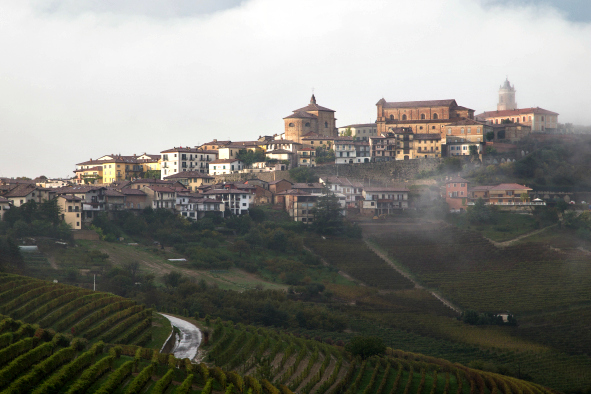Piedmont’s Langhe region has long had a reputation for producing Barolo and Barberesco wines. Since being named Italy’s 50th UNESCO World Heritage Site in 2013, this handsome stretch of rolling countryside is becoming better known.

Vineyards near La Morra (Photo: Chris Allsop)
“It’s Italian style,” says my guide, Fiammetta, laughing and buckling her seatbelt simultaneous to steering the aged Panda around a hairpin bend. After experiencing this procedure following two tastings (had she spat every glass?) and a wine-fuelled three-course lunch, I’d suggested, milquetoast Brit that I am, that perhaps buckling up while stationary was prudent? By the side of the road a grey-haired local steps back onto the verge, her lips pursed as we speed by.
I’m in Piedmont, north-west Italy, swerving around the graceful contours of the Langhe wine region. Two years ago, the Langhe – along with the neighbouring Roero and Monferrato appellations – was declared Italy’s fiftieth UNESCO site. Located south of Alba, its snaking northern border designated by the broad Tanaro river, the Langhe is famous for Barolo and Barberesco, in particular: complex, characterful reds vinified from the Nebbiolo vines planted in its €1m-per-hectare clay-rich soil.
For many, the honour is long overdue – viticulture here dates back to Roman times – but the upside to this neglect is that the Langhe’s lyrical sweep of hilltops encrusted with sun-blushed villages, castles, and Romanesque church towers remains unspoiled. In spring and summer, when the temperature rises, it’s Tuscany without the crowds. In October –when I visit – the Tanaro is turned slate-blue by the rains and the vine leaves are freckling with autumn colour. Doughy mist collects in the valleys, rising as the day warms to expose patchwork slopes stitched with yellow (Nebbiolo) and dark (Barbera) and light (Dolcetto) reds.
I’m staying on one of these photogenic hillsides at the “Barolo-Cru Resort” Palas Cerequio (www.palascerequio.it) – its plush caveau stocks 6,000 bottles from 50 Barolo vintages dating back to 1958. The resort is a renovated palace, as the name suggests, built in 1781 and revived by winemaker Michele Chiarlo and his family. Each of the rooms laid with magisterial terrazzo tile are named for Barolo crus, and the minibar in Villero has the residual whiff of honeyed garlic – the perfumed promise of Tuber Magnatum Pico or the famous Alba White Truffle (the truffle festival is held every weekend in October and November).
The modern reputation of both truffle and Barolo were made in the latter half of the twentieth century – the latter by the collective efforts of innovative producers who tamed “traditional” Barolo’s heavy tannins and greatly reduced the maturation period required to render it drinkable. The modern version, which adheres to quality assurance DOCG (Denominazione di Origine Controllata e Garantita) guidelines, is aged for a minimum of three years before release and made from 100% Nebbiolo (as is Barbaresco). The wine produced has an orange, brickish hue, while a heady blend of roses, violets, tar, truffles, tobacco and prunes can be found in the nose and on the palette.
With time to kill before my first tasting, I hike the twenty minutes from Palas Cerequio to the village of La Morra – one of the five key subzones of the Barolo DOCG. Blue grey lizards slip through the cobbles, and its minute summit somehow supports several cathedral-sized buildings. It’s idyllic now, with some cyclists enjoying white wine as a reward for their hill climb, but, back in the day, they’d lop off a hand if you cut down a Nebbiolo vine. If you were really unlucky, they hanged you.
“It’s been a rainy summer,” says winemaker Pietro Ratti, shrugging his slim shoulders while we’re touring his modernised cellars near La Morra (www.renatoratti.com). Pietro’s father, Renato Ratti, was one of the chief Barolo innovators in the 60s. “It will not be an excellent year,” Pietro continues. “Good, but… when you are used to excellent…” He shrugs. We pause before a break in his cellar’s tall concrete walls, where the blue clay and limestone terroir is left bare for inspection.
Afterwards I have lunch in family-run Antica Torre in Barbaresco, in the shadow of the village’s distinctive square tower. Naturally, it has to be a cherry and spice Barbaresco to drink, paired with buttery ribbons of traditional tajarin pasta covered in flakes of white truffle. Bill Clinton, when he was president, enjoyed Antica Torres’ handmade tajarin so much that he flew chef Cinto Albarello over to cater the White House.
Every Italian that I drink with admits a reluctant preference for Barbaresco over the heavier “wine of kings, king of wines” Barolo. After lunch, we walk off about half a noodle of tajarin touring the tiny village – passing by the high stone walls of Gaja where moderniser Angelo had full blooded rows with his traditionalist father en route to creating perhaps the Langhe’s most illustrious brand – before it’s time to get back into the Panda and on to the next tasting. As I nervously side-eye Fiammetta’s unengaged seat belt, perhaps I should take heart from the local history: tradition is all well and good, but safe did not the Langhe make.
For more information on the region go to: www.langheroero.it
WHERE TO STAY
Palas Cerequio (www.palascerequio.it) – A renovated palace, as the name suggests, built in 1781 and revived by winemaker Michele Chiarlo and his family. The rooms are named for Barolo crus and wine tastings can be arranged on site in the well-stocked wine cellar.
VinCafè (www.vincafe.com), located in the medieval town of Alba (the capital of the Langhe), combines an excellent local wine list with friendly staff and stylish rooms.

